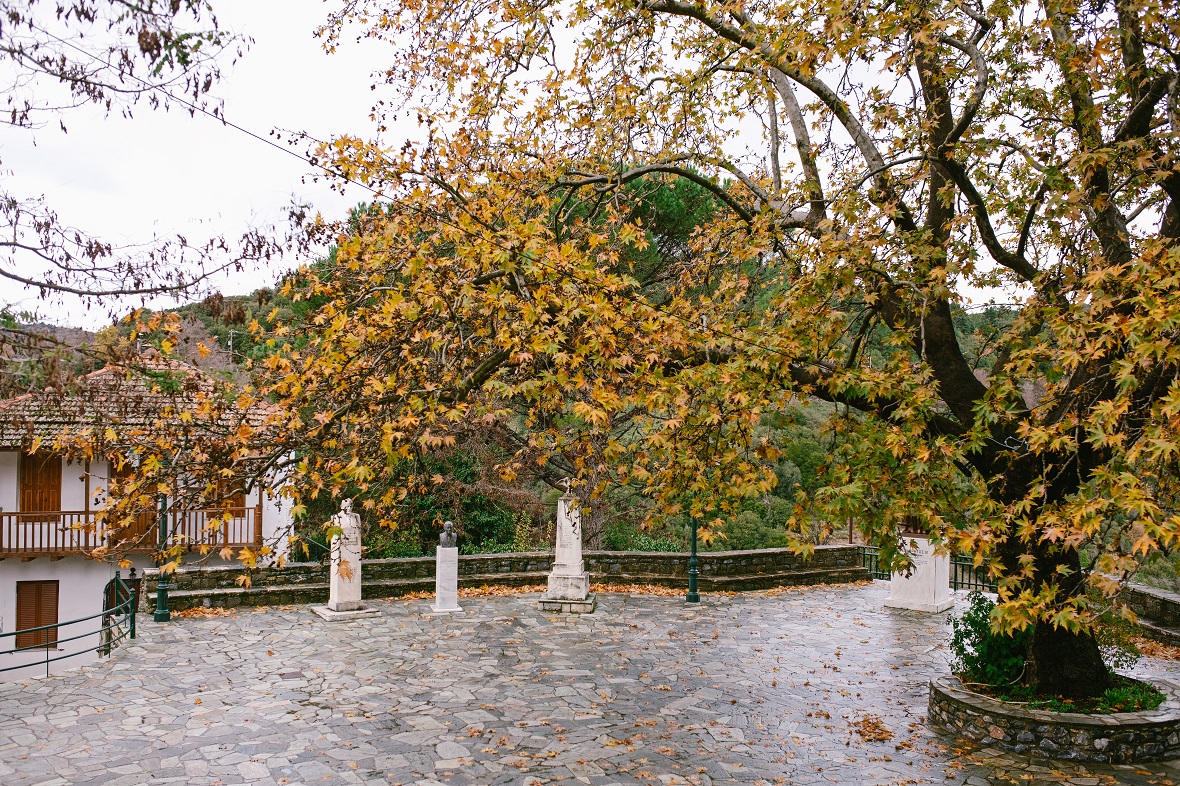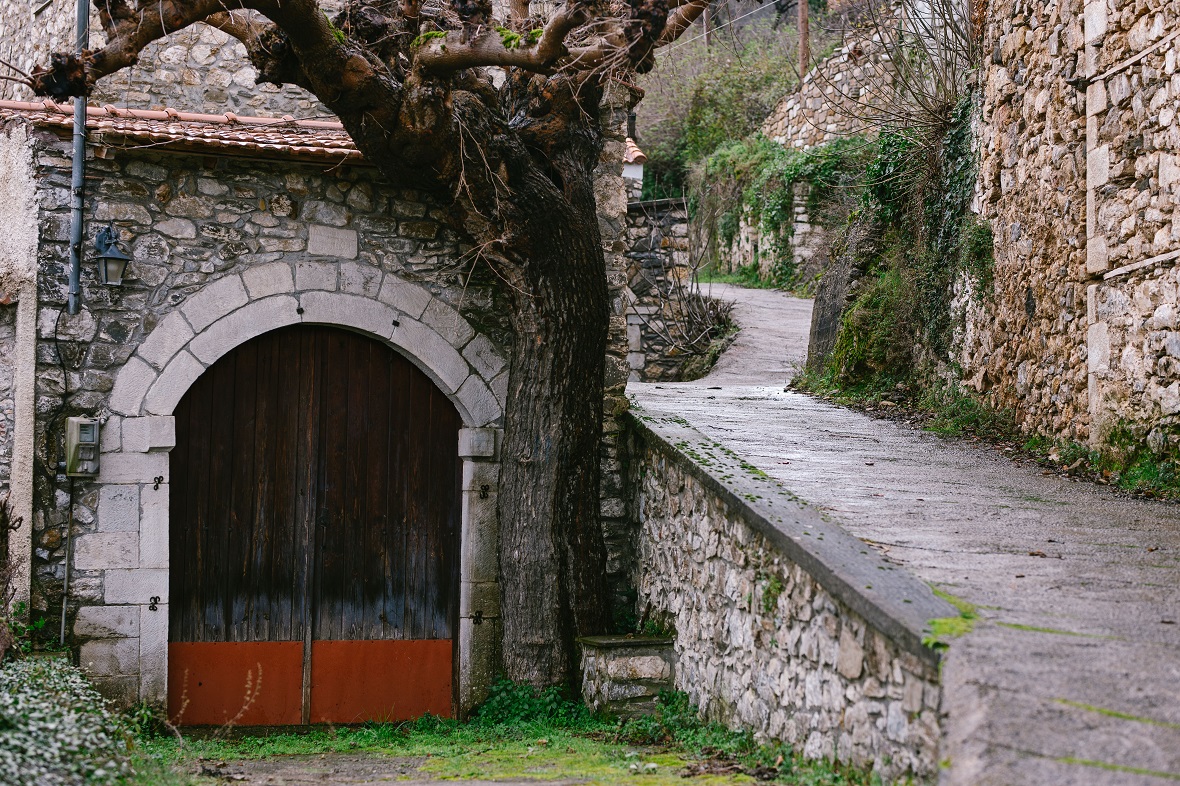Can a once-thriving mountain village, today home to only nine inhabitants, come to life again?
Can it fill with visitors, permanent inhabitants, and model businesses while retaining its traditional character? This is the wager laid by a group of five young people who want to revitalize the village of Vamvakou, 900 meters up the slopes of Mount Parnon in the southeastern Peloponnese.
To realize this ambitious project, the five friends, Haris Vasilakos, Anargyros Verdilos, Eleni Mami, Tasos Markos, and Panagiotis Soulimiotis established the “Vamvakou Revival” Social Cooperative Enterprise and decided to move to the village. From the beginning the group has had the Stavros Niarchos Foundation (SNF) at its side providing guidance and financial support to its effort. The village is also the ancestral homeplace of Stavros Niarchos, the founder of the SNF, and as such holds both special symbolic and emotional significance for the organization.
The Vamvakou Revival group is working systematically to draw up and implement a five-year plan for sustainable development of the village and the return of inhabitants. Key intermediate stages will be to create jobs and ensure comfortable living conditions, with the ultimate goal that in a few years Vamvakou will be inhabited by young people, families, and children and that the village school, which closed in 2008, will open again.
The first stage of the Revival of Vamvakou is using the natural advantages that Mount Parnon offers. In the summer, the group will be ready to welcome the first visitors to the village, organizing outdoor activities including hiking, cycling, guided tours, and free creative activities for kids and providing a comprehensive sporting and recreational experience for pros and amateurs alike. At the same time, the necessary planning is underway for the operation of a restaurant-café and a traditional guesthouse.
The Vamvakou Revival group is ready to take this step forward, both for themselves and for the generations to come: “Life in the village is in and of itself a challenge. We would call it a social experiment. Of course it takes strength to create the right conditions, but we have a vision to keep moving forward and to believe in a new Greece with improved rural life. When children’s voices are heard, when the first bell is heard in the village school, then we can talk about a new Vamvakou and a revival plan with a measurable result! The village has been tested by history, has been hit by emigration and the financial crisis, and is now asking for our participation to begin a new chapter. The Stavros Niarchos Foundation gives us the paper and pen.”
The idea of the revitalizing Vamvakou had the full support of the Stavros Niarchos Foundation and its Co-President, Andreas Dracopoulos, from the very first moment, even before it had matured into an organized plan: “The revival of Vamvakou is a very ambitious project which, we believe, expresses a collective need, today perhaps more than ever, to return to our roots with respect and hope. Our own roots happen to be in Vamvakou, as it is the village where my great uncle and our founder, Stavros Niarchos, came from. Respecting its tradition and its history, we look forward to seeing Vamvakou gradually fill with life and evolve into a model village, paving the way for other such villages to follow, both in Greece and internationally.”
# # #
Vamvakou, Prefecture of Laconia
Vamvakou was built in the mid-15th century.
The village is built at an altitude of 903 meters, on the slopes of Mount Parnon.
It is 36 km from Sparta and 210 km from Athens.
Well-known villages in the surrounding area are Karyes and Varvitsa.
Vamvakou boasts great natural beauty and a long history.
Prior to the Greek War of Independence against the Ottoman Empire that began in 1821, 200 large families lived in Vamvakou. Its demographics were severely affected by the German occupation, the civil war, emigration, and urbanization. The main destinations of Vamvakou’s inhabitants abroad were the United States, Russia, and Africa.
Until 1900, the Vamvakites (the people of Vamvakou) worked in agriculture, livestock farming (35,000 cattle), winemaking, and cereal farming. After 1900 and the catalytic activity of the Union of Plenipotentiaries*, Vamvakou turned to the cultivation of trees (cherry, sour cherry, apple, pear, chestnut, and walnut), potatoes, and herbs, which were used as remedies. Indeed, many who came from Vamvakou chose medicine as a profession. Based on data regarding their average lifespan, Vamvakites lived for many years.
Today, the main occupations of its inhabitants are livestock farming and agriculture (potatoes, walnuts, chestnuts, and garden produce), while the region is known for its honey, its aromatic tea, and its oregano.
* In 1898, wishing for their village to grow and prosper, the Vamvakites set up—in parallel to the existing administrative system—a committee of 20 members, which they called the “Union of Plenipotentiaries of the Community of Vamvakou.” Its aim was to shape a modern population. When the Union completed its activity in 1914, it had achieved a great deal in education, organized livestock farming, agriculture, horticulture, moral improvement, and electoral freedom. Indeed, the Law on the Municipalities and Communities, introduced by Eleftherios Venizelos in 1912 in Parliament, was modeled on the Statute of the Union of Plenipotentiaries.
###
During the implementation of the project, the Stavros Niarchos Foundation (SNF) and Vamvakou Revival will provide progress updates on the work. This coming July, SNF’s monthly DIALOGUES event will take place in the village of Vamvakou, focusing on the work being done there by the team for the revival of the village.

Source: SNF

Source: SNF

Source: SNF